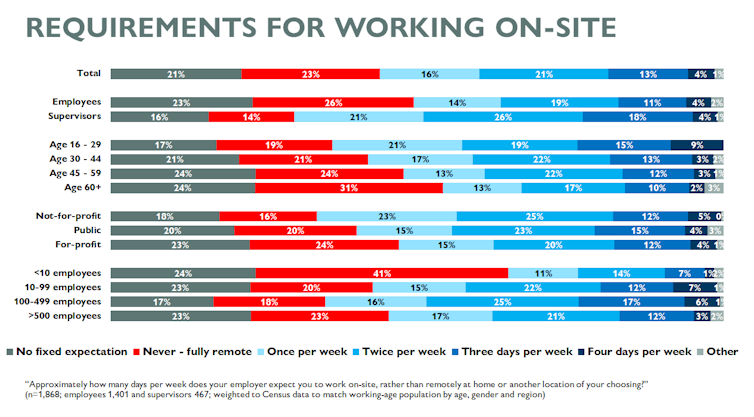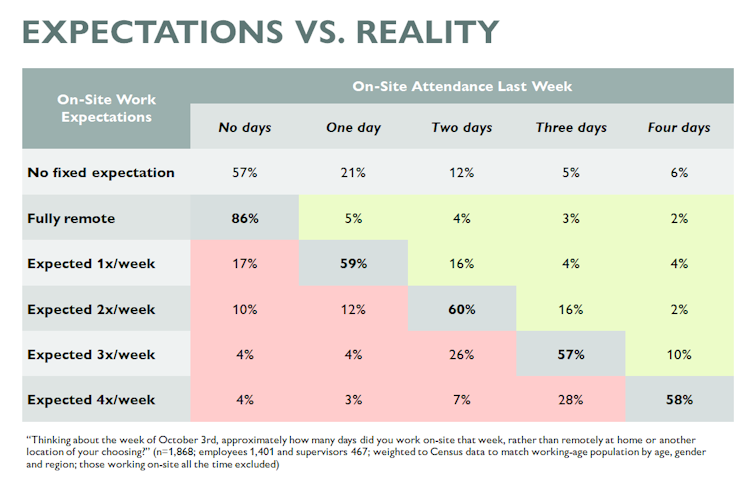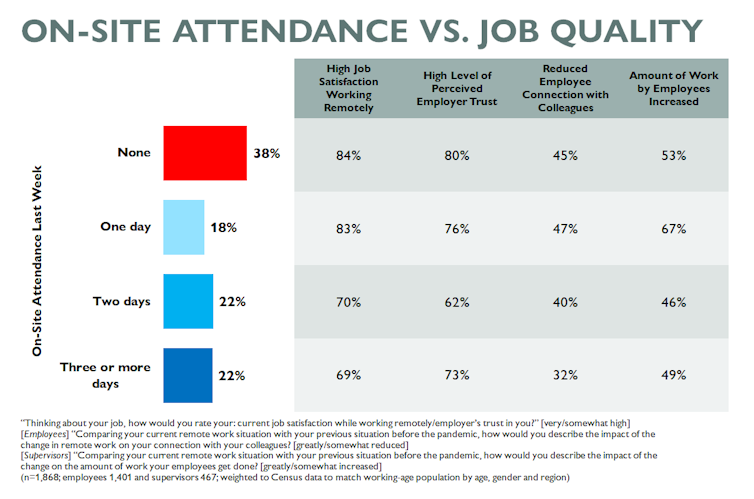
Sam Andrey, Toronto Metropolitan University; Cory Searcy, Toronto Metropolitan University, and Patrick Neumann, Toronto Metropolitan University
The COVID-19 pandemic spurred a global shift to remote work, with the latest evidence suggesting almost half of workers in Canada are still regularly working remotely. Employers are grappling with how to strike the right balance between flexibility for work from home and expectations for in-person time together.
In November, Elon Musk announced the end of remote work at Twitter — a move 80 per cent of Canadians said would cause them to quit. Some of Canada’s largest companies are taking diverging approaches, from Shopify’s “work anywhere” policy to some of the big banks moving to two or three in-person days a week.
A new survey by Toronto Metropolitan University with the support of the Future Skills Centre provides new insights into the ongoing transition to hybrid workplaces. The study, conducted in October 2022 with 1,500 employees and 500 supervisors who regularly work remotely, aimed to shed light on how Canadian workers are feeling and being supported.
Remote workers like remote work
The study’s first major finding will come as no surprise: remote workers like remote work. Both employees and supervisors were more likely to rate their job satisfaction as somewhat high while working remotely (78 per cent) than when working in person (41 per cent).
Compared to before the pandemic, 60 per cent of remote workers said their work-life balance has improved. More than half of employees (54 per cent) said the amount of work they got done increased as a result of remote work. A similar proportion of supervisors agreed (52 per cent), while just 15 per cent said their employees’ output decreased because of remote work.

What’s the catch?
Remote work has impacted workers’ sense of connectedness and can result in loneliness and lack of social support. When respondents were asked if the shift to remote work had impacted connection with their colleagues, 43 per cent said their connection had declined, while only 21 per cent said their connection had improved.
It’s understandable that many organizations are trying to set expectations for on-site work at least some of the time.
Flexible in-person expectations
The survey found nearly half of remote workers either had no fixed in-person work requirements or worked entirely remotely. Another 37 per cent were expected to work in person once or twice a week and only 17 per cent were expected to work in person three or more days a week.

However, expectations did not always match reality. When remote workers were asked how often they actually worked on site in the week prior to the survey (the first week of October), about 67 per cent went worked the required amount of days, 17 per cent went in less often and 16 per cent went in more often.

Remote workers without fixed in-person expectations, or who were fully remote, tended to report lower stress levels, higher levels of trust in their employers and better job performance. However, these same workers also reported lower levels of connection to their colleagues. To balance the costs and benefits of working remotely, one approach seems to hit a sweet spot: working one day per week in person.
Flexibility increases satisfaction
Job satisfaction with remote work didn’t fall significantly when people worked one day a week in person. Eighty-four per cent of workers (employees and supervisors) had high satisfaction working fully remotely and 83 per cent had high satisfaction working in person one day a week. For workers that worked two or more days in person, that number dropped to 70 per cent.
Similarly, the perceived level of trust workers said their employers had in them didn’t change significantly when people worked one day a week on site.
Eighty per cent of fully remote workers, and 76 per cent who worked one day a week in person, felt their employers had high trust in them. This number decreased to 62 per cent once workers started working two or more days in person.

Hybrid work also impacted how management viewed the productivity of their employees.
Sixty-seven per cent of supervisors who worked in person one day a week believed their employees were more productive, while only 47 per cent of supervisors who worked two or more days a week did. Of supervisors who were fully remote, 53 per cent believed their employees were more productive.
But did working one day a week in person solve the challenge of connectedness with colleagues? Not quite — those working one day a week in person still reported an overall loss of connectedness to colleagues. But that reversed when employees worked three or more days in person, which correlated with significant drops in perceived job satisfaction and performance.
The future of remote work
Most Canadians who work remotely are still very satisfied and able to get more work done with less stress. This latest survey suggests about half of employers are letting their employees choose when to work in-person. And of those with specific expectations, many employees work less or more in-person than they are expected to.
The biggest issue for employers is how to maintain flexibility while keeping teams connected and productive. Employers across the country are grappling with the right approach to mandating back-to-work requirements, while also balancing concerns about team performance and culture.
In this new world of hybrid work, managers need to support their teams with high-quality working conditions that build and maintain interpersonal connections while allowing for both high productivity and superior job satisfaction.
For employers requiring on-site attendance, this new survey indicates that working one day a week in person might be a sweet spot for maintaining job satisfaction and performance, while still providing opportunities for building in-person connections.![]()
Sam Andrey, Director of Policy & Research, Leadership Lab, Toronto Metropolitan University; Cory Searcy, Professor, Mechanical and Industrial Engineering, & Vice-Provost and Dean of Graduate Studies, Toronto Metropolitan University, and Patrick Neumann, Professor, Department of Mechanical and Industrial Engineering, Toronto Metropolitan University
This article is republished from The Conversation under a Creative Commons license. Read the original article.

